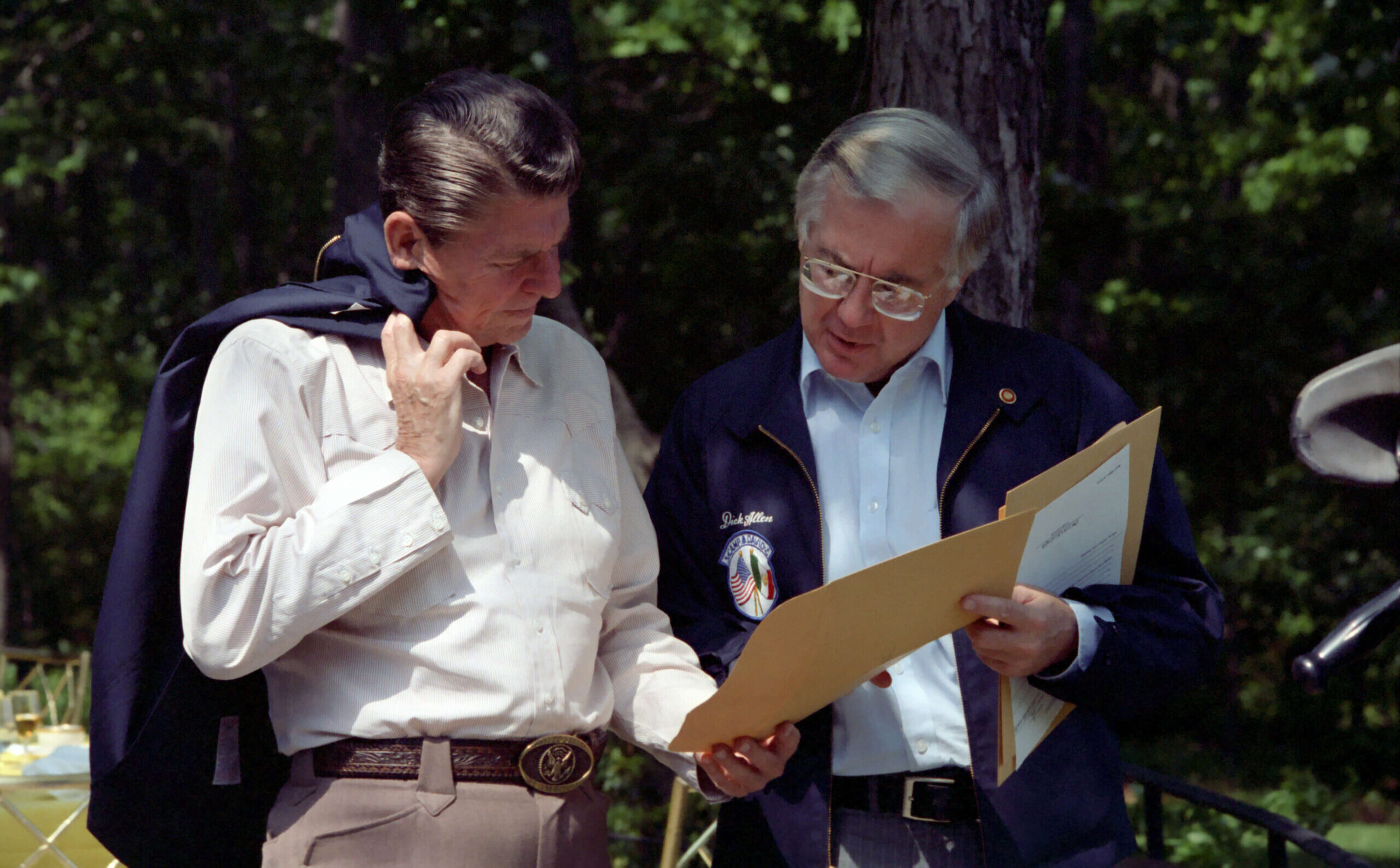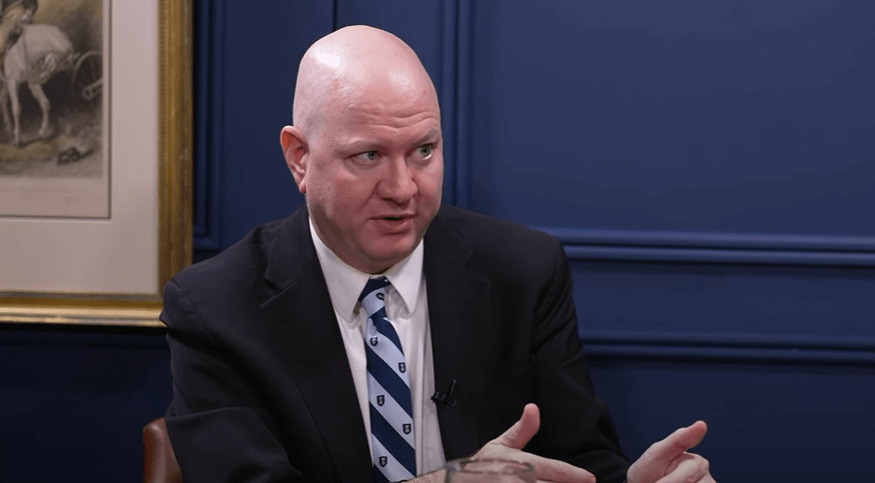Inventing the Individual: The Origins of Western Liberalism
by Larry Siedentop (Cambridge, MA: Harvard University Press, 2014)
At one point in Monty Python’s Life of Brian, the ridiculous protagonist finds himself at an upper window, addressing a large crowd of determined, sheeplike followers: “You don’t need to follow me,” he cries. “You’ve got to think for yourselves. You’re all individuals!” To which the crowd roars back in unison: “Yes! We’re all individuals!” A lone dissenter raises his hand: “I’m not!” but is quickly hushed by the rest, finishing the delicious absurdity of the scene with a last dash of irony. Brian’s failure, though, is Monty Python’s success: in a minute and a half, the film captures both the awkward paradox of modern Western self-understanding—we all identify as individuals, despite our predictable herd behavior—and the fact that this point of view simply did not exist in the first century AD.
That paradox and this fact are the beginning points and the raison d’être of Larry Siedentop’s new book, Inventing the Individual: The Origins of Western Liberalism: he wants to explain how it is that we came to see ourselves this way, because of what has unfolded between the first century and our own. More precisely, his book credits Christianity with the “invention of the individual,” as well as a surprising number of our other modern accoutrements, usually credited to (or blamed on) the Enlightenment or revolutionary periods.
In making such a claim, Siedentop pits his account against two related kinds of rival narratives: first, the tired triumphalist fables spread by certain early-modern thinkers—Petrarch, Erasmus, Hobbes, Gibbon—according to which the Dark Ages had thankfully been left behind by a new coterie of truth tellers; second, the myriad critiques of modernity, many of them tinged with Romantic nostalgia, which also present the Renaissance or Enlightenment as a kind of rupture in relation to a more desirable premodern past.
Needless to say, both families of rival narratives claim their adherents to this day: the academy and many popular depictions (for example, Stephen Greenblatt’s The Swerve [2011]) still presume and defend the triumphalist narrative; on the other hand, certain kinds of traditionalists (for example, Wendell Berry) continue to long for the past in the face of the radical difference of modernity. Among political theorists, both those enthusiastic about modernity (John Rawls, Jürgen Habermas, and others) and its critics (Leo Strauss, Alasdair MacIntyre, and others) have generally seen it as a decisive break with an older order. The individual, possessor of rights and sovereign basis of political power, equal to all and yet uniquely accountable only to personal conscience, is a modern phenomenon, a modern invention.
Nevertheless, a third way has been opened (or reopened) over the past century—that of presuming and indeed finding continuity between medieval and modern, rather than rupture—and it is along this path that we find Siedentop making his way. It is a path already well marked out by scholars such as Walter Ullmann, Brian Tierney, and Francis Oakley, though there is work yet to be done in making its outlines clear. This third way of accounting for the rise of the individual, and for the development of modern liberalism more broadly, tends to rely on narratives of the development of self-understanding in the West, narratives made dramatic by the unfolding of powerful principles, present in the original teachings of the Christian faith, and worked out over centuries into doctrines that prepare the way for modern liberal self-understanding.
Siedentop unfolds his own version of this narrative in six stages. Chapters 1 to 3 describe the ancient world, rooting its self-understanding in the religious cults of family and city. He presses the point of its essentially religious character in response to the view, spread by Renaissance humanists, that ancient Greece and Rome were somehow more “secular” than the Christian Middle Ages. Their religious cults, according to Siedentop, affirmed the family as the basic unit of society and enshrined the idea of a basic inequality among persons, an inequality the ancients found reflected in the order of nature at large.
In the second section, chapters 4 through 8, Siedentop describes the “Moral Revolution” Christianity brought about in the early centuries of this era, from the time of Paul to that of Augustine. The revolution, for Siedentop, begins with the introduction of a new principle of human nature, first theorized by Paul, and most evident in a famous line of his letter to the Galatians: “There is neither Jew nor Greek, there is neither slave nor free, there is neither male nor female; for you are all one in Christ Jesus” (3:28). Here, the individual’s relation to Christ trumped all other differences, whether of tribe, class, or even sex: it was an egalitarian principle that would work itself out in various ways over the centuries that followed.
Along with radical equality, this new way of thinking fostered a sense of inwardness, which Siedentop finds reflected in the early monastic movement: the most important events in life now occurred within each human soul, rather than in any particular external actions. The mystical Cities of God and Man, theorized by Augustine, were composed of individual souls who had chosen to follow either Christ or themselves, respectively, and these Cities became much more important than the earthly City, with its physical bounds and merely external practices. Thus, the Christian Revolution had, in Siedentop’s telling, turned the pagan world upside down.
The next four sections follow from the first two, tracing the social, legal, political, and philosophical changes that were gradually brought about under the pressure of the new Christian principles. “More than anything else . . . Christianity changed the ground of human identity,” and that change eventually necessitated structural shifts of all kinds in human life (353).
Siedentop’s third section (chapters 9–12) depicts the early-medieval shift in power relations, as political and tribal leaders found themselves faced with a new and greater authority: the clergy. Now that individual souls were the paramount consideration, spiritual leaders could (where necessary) trump the claims of families, cities, and rulers; and these were parties who were not used to being trumped. The conflict between spiritual and temporal powers would regularly arise, requiring constant theological and legal consideration of the grounds of authority in a Christian world.
In section 4 (chapters 13–16), Siedentop then describes two interrelated crises in the tenth, eleventh, and twelfth centuries: after the fall of the Carolingian Empire, secular power grew more decentralized and unstable, spread not only between kings but also between a multitude of aristocratic lords in their newly built castles; at the same time, many bishoprics and clerical positions had come under the sway and patronage of noble families, endangering the independence of the Church. The first crisis meant that the people began to look more to the Church, and especially the monasteries, for a principle of unity and an example of stable government—a critical turn, as monasteries were more likely to be governed on the basis of the common consent of individuals.
The second crisis, the famed Investiture Controversy, brought about a strengthening of the papacy under Gregory VII and other reformers, who insisted on the freedom and separation of the spiritual authority from the temporal authority. Meanwhile, a greater and greater effort was made to defend that liberty and authority canonically, in terms not only of natural law but of the “natural rights” of the souls under the Church’s care.
In the fifth section (chapters 17–20), Siedentop follows the influence that Church reforms and a centralizing papacy bore on European thought about governance in general. As popes and canon lawyers increasingly defended the authority of the Church on the grounds of the spiritual needs and natural rights of individuals, the idea of a popular ground of authority become easier to imagine, even in the secular sphere. At the same time, the centralization of the papacy threatened the authority of cardinals and bishops, leading to another prolonged power struggle and the development of a “conciliar” theory of authority in the Church, a theory that would lay the groundwork for subsequent moves toward parliamentary government in secular politics.
The sixth section (chapters 21–25) then brings the argument to a close by describing the further development of rights-theory in church government and the nominalist theology of William of Ockham, each of which ushered the Church into the fifteenth century, the eve of the Reformation and rise of the nation-state. A peculiarity of Siedentop’s reading is his association of strong claims about reason and nature (such as one finds in Aristotle, and later in Aquinas) with the essentially pagan desire to defend social hierarchy and maintain relationships of inequality. Ockham, on Siedentop’s account, overturned this tendency in the dominant Thomism, by emphasizing the radical freedom of God from all trammels, natural, rational, or otherwise; just as God’s will was radically free, so too were the wills of those created in his image, and this strong theory of human freedom exerted a powerful influence over late-medieval society, further extending the principles of the Christian Revolution. As Siedentop argues, this voluntaristic shift, together with the movements toward equality, popular sovereignty, natural rights, and parliamentary representation, formed exactly the foundation modern liberalism needed to get started. Christianity, as the narrative goes, invented the individual.
And much of this narrative seems to be correct. Larry Siedentop is a gifted writer, and he tells the story in vigorous prose, with a fine eye for detail and a penchant for synthesis. At the same time, Inventing the Individual suffers from several of Siedentop’s authorial choices: one is that he has chosen to write a popular account, and thus has left out most of the footnotes one might expect, giving us instead recommendations for further reading.
This is not a problem per se, but it is for Siedentop, and for two reasons: first, because he is making challenging claims, a number of which are hotly disputed among scholars in the field (for example, among many others, that Paul was influenced by Neoplatonism, or that Thomism dominated the fourteenth-century schools); secondly, because Siedentop has no previous major publications in most of these periods. His expertise has been nineteenth-century French thought, and political theory more generally, so that we might be excused for not expecting him to be an expert on all the periods he covers here. Thus the need for clearer grounds.
A second, related critique: in the few notes he does include, Siedentop makes clear that he has developed this wide-ranging account almost entirely on the basis of secondary sources, some of them not the freshest. As Siedentop acknowledges, his first three chapters are largely developed out of Fustel de Coulanges’s Ancient City (1864), a fine work but one that has been justly criticized from multiple angles; a substantial portion of his chapters on early Christianity come straight out of the work of contemporary scholar Peter Brown; and his chapters on the central and later Middle Ages owe the most to the contemporary work of Brian Tierney. Now, again, there is nothing wrong with the extensive use of secondary sources, but it does diminish Siedentop’s capacity to persuade, and a self-consciously Grand Narrative like this one needs every favorable sign it can muster in behalf of its legitimacy. At the least, we need him to show us that he knows the primary sources, and well.
Finally, a more philosophical disagreement: Siedentop’s account pits a liberated, individualist, voluntarist Christianity against a paganism bound by family, cult, reason, and nature. While he is right that Christian principles necessarily push in the direction of free will and individual responsibility, it strikes me as unnecessary to suggest that Christianity finally forces us to choose between will and reason, liberty and submission, individuality and community. While it is possible to imagine such a choice in theory, it seems absurd to say that it has ever existed in practice: will cannot make choices without reason any more than reason can cause motion without will, and the case is similar with the other supposed binaries. This philosophical problem and others like it work together with the relative lack of primary sources to give the impression that Siedentop’s book is likely to be oversimplifying for the sake of theoretical neatness. A better grounded and more complex account is needed if we are to get closer to the truth about these difficult questions.
Thankfully there are a number of other fine scholars working on the same questions right now, and I would recommend two in particular, as covering Siedentop’s ground, but with greater rigor and appreciation of the difficulty of the terrain: for one, the French historian and philosopher Rémi Brague has two installments of a trilogy, The Wisdom of the World (2003) and The Law of God (2008) in English translation, and the third volume is being published in French this year. At the same time, the American historian Francis Oakley is publishing the third volume of his own trilogy on The Emergence of Western Political Thought in the Latin Middle Ages (2010, 2012, 2015). Both these scholars do all the original-language, primary-source work we rightly expect of this kind of argument, and they treat the emergence of modern self-understanding with the care it deserves. If Monty Python’s Brian is right, and we all became individuals sometime in the first century, perhaps without even realizing it, we are going to need the best help we can get. ♦
Dwight Lindley is assistant professor of English at Hillsdale College, specializing in Victorian literature and philosophy.














